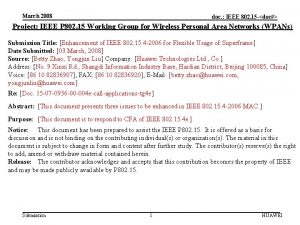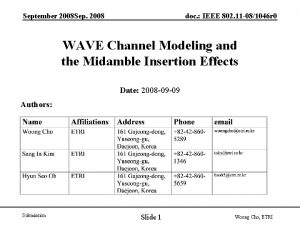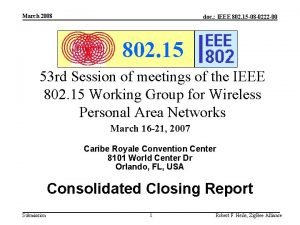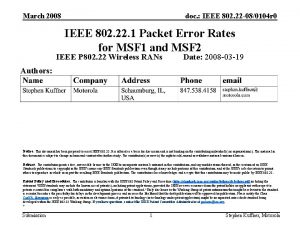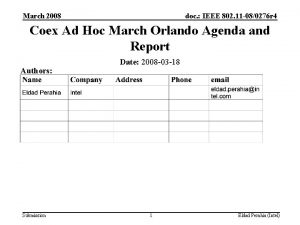March 2008 doc IEEE 802 11 080349 r








- Slides: 8

March 2008 doc. : IEEE 802. 11 -08/0349 r 0 Potential Benefits of Dual-radio VHT Systems Date: 2008 -03 -18 Authors: Submission 1 Harkirat Singh, et al. , Samsung Electronics

March 2008 doc. : IEEE 802. 11 -08/0349 r 0 Abstract [ 60 GHz band provides the potential for multiple Gigabit data rate with limited coverage. On the other hand, <6 GHz provides a larger coverage but limited data rate increase. The main objective of this presentation is to share some thoughts on how the two radios can complement each other. ] Submission 2 Harkirat Singh, et al. , Samsung Electronics

March 2008 doc. : IEEE 802. 11 -08/0349 r 0 Pros and Cons of 60 GHz band Pros Cons • Easy to achieve >1 Gbps per-link throughout • Limited coverage due to severe path loss and obstruction • Difficult to provide same user experience as. 11 x without additional improvement • Needs additional radio for backward compatibility w/ 802. 11 x (if needed) – Large (7 GHz) contiguous bandwidth • Small form factor – Antenna spacing (λ/2) ≈ 0. 25 cm • Support directional transmissions and opportunities for spatial reuse • Relatively simple transceivers design – Not necessary to achieve high spectral efficiency Submission 3 Harkirat Singh, et al. , Samsung Electronics

March 2008 doc. : IEEE 802. 11 -08/0349 r 0 Dual-radio VHT systems • VHT STA includes two radios: 60 GHz radio and <6 GHz radio – <6 GHz radio also covers other 11 x radios • When operating at 60 GHz and is blocked, fallback to <6 GHz. It is like 11 n falls back to • <6 GHz radio may provide backward compatibility with 11 x (such as 11 n/. . ) Submission 4 Harkirat Singh, et al. , Samsung Electronics

March 2008 doc. : IEEE 802. 11 -08/0349 r 0 <6 GHz assists 60 GHz <6 GHz transmission range AP 60 GHz directional transmission • <6 GHz facilitates in: – – Quickly disseminating some time critical info such as neighbor table, scheduling of 60 GHz links, etc. Boosting aggregated throughput of 60 GHz via SDMA (concurrent non-overlapping transmissions), MUD, etc. Submission 5 Harkirat Singh, et al. , Samsung Electronics

March 2008 doc. : IEEE 802. 11 -08/0349 r 0 Illustration <6 GHz transmission range AP 3 Schedules, Neighbor info, etc. Neighbor id Quality Angular … … … (local view) Submission 6 Harkirat Singh, et al. , Samsung Electronics

March 2008 doc. : IEEE 802. 11 -08/0349 r 0 Summary • Presented some thoughts on the potential benefits of having both <6 GHz and 60 GHz radios together • This results in: – Enlarging 60 GHz coverage – Improving aggregated system throughput – Enhancing user WLAN experience Submission 7 Harkirat Singh, et al. , Samsung Electronics

March 2008 doc. : IEEE 802. 11 -08/0349 r 0 Thank you! Submission 8 Harkirat Singh, et al. , Samsung Electronics









